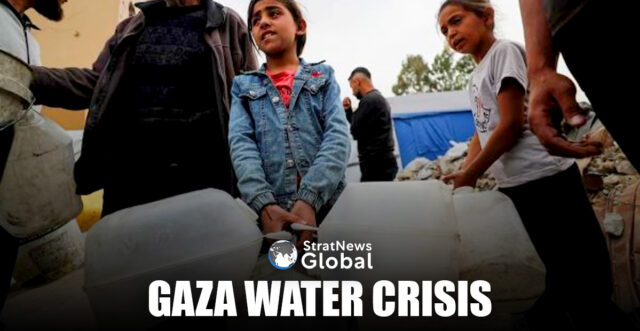Hundreds of thousands of residents in Gaza City lost their primary access to clean water over the past week after Israel’s renewed military offensive led to the shutdown of supplies from its water utility, according to local municipal officials.
Many now have to walk, sometimes for miles, to get a small water fill after the Israeli military’s bombardment and ground offensive in Gaza City’s eastern Shejaia neighbourhood, in the north of the Strip, damaged the pipeline operated by state-owned Mekorot.
“Since morning, I have been waiting for water,” said 42-year-old Gaza woman Faten Nassar. “There are no stations and no trucks coming. There is no water. The crossings are closed. God willing, the war will end safely and peacefully.”
Israel To Address Malfunction Of Pipelines
Israel’s military said in a statement it was in contact with the relevant organisations to coordinate the repair of what it called a malfunction of the northern pipeline as soon as possible.
It said a second pipeline supplying southern Gaza was still operating, adding that the water supply system “is based on various water sources, including wells and local desalination facilities distributed throughout the Gaza Strip”.
Israel ordered Shejaia residents to evacuate last week as it launched an offensive that has seen several districts bombed. The military has said previously it was operating against “terror infrastructure” and had killed a senior militant leader.
The northern pipeline had been supplying 70% of Gaza City’s water since the destruction of most of its wells during the war, municipal authorities say.
“The situation is very difficult and things are getting more complicated, especially when it comes to people’s daily lives and their daily water needs, whether for cleaning, disinfecting, and even cooking and drinking,” said Husni Mhana, the municipality’s spokesperson.
We are now living in a real thirst crisis in Gaza City, and we could face a difficult reality in the coming days if the situation remains the same.”
Worsening Water Crisis
Most of Gaza’s 2.3 million people have become internally displaced by the war, with many making daily trips on foot to fill plastic containers with water from the few wells still functioning in remoter areas – and even these do not guarantee clean supplies.
Water for drinking, cooking and washing has increasingly become a luxury for Gaza residents following the start of the war between Israel and the Palestinian militant group Hamas, whose fighters carried out the deadliest attack in decades on Israel in October 2023, killing 1,200 people in southern Israel and taking some 250 hostages, according to Israeli tallies.
Since then, more than 50,800 Palestinians have been killed in Israel’s military campaign, Palestinian authorities have said.
Many residents across the enclave queue for hours to get one water fill, which usually is not enough for their daily needs.
“I walk long distances. I get tired. I am old, I’m not young to walk around every day to get water,” said 64-year-old Adel Al-Hourani.
The Gaza Strip’s only natural source of water is the Coastal Aquifer Basin, which runs along the eastern Mediterranean coast from the northern Sinai Peninsula in Egypt, through Gaza and into Israel.
But its salty tap water is severely depleted, with up to 97% deemed unfit for human consumption due to salinity, over-extraction and pollution.
Water Sources ‘Inoperable’
The Palestinian Water Authority stated that most of its wells had been rendered inoperable during the war.
On March 22, a joint statement by the Palestinian Bureau of Statistics and the Water Authority said more than 85% of water and sanitation facilities and assets in Gaza were completely or partially out of service.
Palestinian and United Nations officials said most of Gaza’s desalination plants were either damaged or had stopped operations because of Israel’s power and fuel cuts.
“Due to the extensive damage incurred by the water and sanitation sector, water supply rates have declined to an average of 3-5 litres per person per day,” the statement said.
That was far below the minimum 15 litres per person per day requirement for survival in emergencies, according to the World Health Organization indicators, it added.
(With inputs from Reuters)





